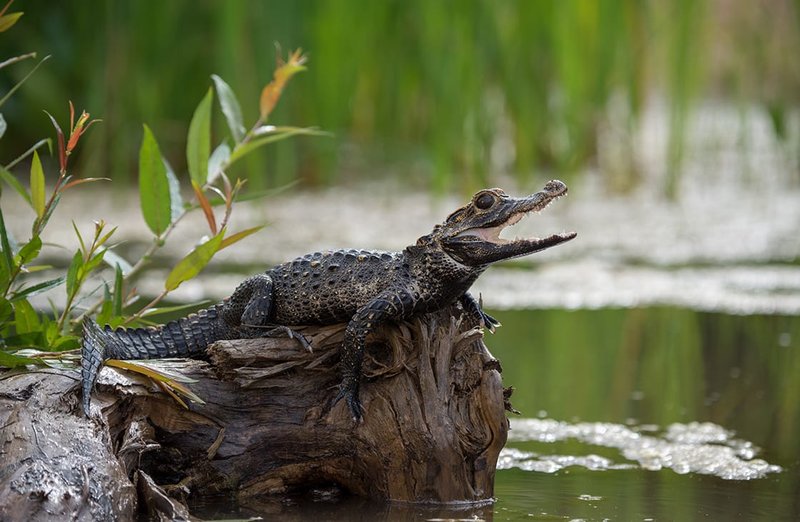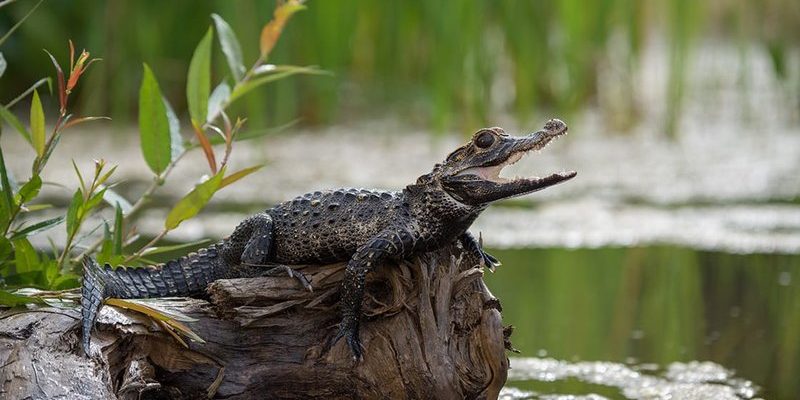
Caimans are fascinating reptiles that often spark curiosity and admiration. These creatures are often confused with their larger relatives, the alligators and crocodiles, but they have unique traits that set them apart. Imagine stumbling upon a small dinosaur lurking in the murky waters of a tropical river—that’s the essence of spotting a caiman. Known for their distinctive appearance and everyday habits, caimans play a vital role in their ecosystems, particularly in Central and South America.
When you think of caimans, picture their sleek, elongated bodies gliding silently through the water, with eyes peeking just above the surface. They are expert swimmers and can often be found basking on riverbanks, soaking up the sun. With a blend of curiosity and caution, we’re about to explore the world of caimans, examining their habitats, behaviors, diets, and more. Get ready to dive into the life of these remarkable reptiles!
What Are Caimans?
Caimans belong to the family Alligatoridae, which also includes alligators. While there are several species of caimans, the most notable include the Spectacled Caiman, Yacare Caiman, Broad-snouted Caiman, and Black Caiman. The largest among these, the Black Caiman, can grow up to 16 feet long! It’s impressive, right? Caimans are often found in freshwater habitats like rivers, lakes, and swamps, primarily in countries such as Brazil, Colombia, and Venezuela.
One key feature that distinguishes caimans from their relatives is their smaller size. Caiman species tend to be less intimidating than alligators or crocodiles, but don’t let their size fool you. They are still formidable predators. Their sharp teeth and strong jaws are designed for catching prey. So, when you’re identifying a caiman, look for its broad snout and the unique patterns on its skin, which offer fantastic camouflage against the water’s surface.
Caiman Habitats
Caimans thrive in various freshwater ecosystems, making them highly adaptable reptiles. They prefer habitats that provide plenty of vegetation, which offers both food and shelter. You can typically find them in tropical rainforests, where rivers weave through dense foliage, creating a perfect setting for these reptiles to hunt and bask. They’re especially abundant in the Amazon Basin, where conditions favor their survival.
Unlike some reptiles that can tolerate brackish water, caimans are primarily freshwater dwellers. They rely on stable water levels to hunt effectively and regulate their body temperature. During the dry season, caimans often gather in deeper pools, sometimes leading to dramatic displays of social behavior as they compete for resources. It’s a striking image—dozens of these reptiles lounging together in the sun, all while keeping an eye out for potential predators or rivals.
Caiman Diet and Feeding Behaviour
Caimans are carnivorous, and their diet is as varied as their habitats. Depending on their size and species, they eat a range of prey, from fish and crustaceans to small mammals and even birds. Their hunting technique is fascinating. Caimans often lie in wait, partially submerged to avoid detection. When they see a meal approach, they strike swiftly, using their powerful jaws to capture it.
Juvenile caimans focus on smaller fish and insects, gradually moving on to larger prey as they grow. Interestingly, they play a crucial role in their ecosystem by helping control fish populations. This balance ensures that no single species overpopulates, maintaining the health of the water body they inhabit. And let’s not forget their unique ability to scavenge; caimans will often feed on carrion if the opportunity arises, showcasing their opportunistic feeding habits.
Caiman Social Structure
You might be surprised to learn that caimans can be quite social animals. While they are solitary hunters, they often gather in groups when basking in the sun or during the breeding season. Male caimans can be territorial, particularly during mating times, leading to displays of dominance among males. They often engage in vocalizations, like deep bellows and hisses, to communicate with each other and establish their presence.
During the breeding season, which usually occurs in the warmer months, the social dynamics can shift. Males will call out and display their strength to attract females. Once paired, the female will lay around 20 to 60 eggs, burying them in the sand or vegetation. Interestingly, female caimans exhibit maternal care—guarding their nests and even helping the hatchlings reach the water after they break free from their eggs. This nurturing behavior highlights the deep bonds between caimans and their offspring.
| Characteristic | Details |
|---|---|
| Size | Varies by species; Black Caiman can reach up to 16 feet |
| Habitat | Tropical rainforests, rivers, lakes, and swamps |
| Diet | Carnivorous; fish, crustaceans, small mammals |
| Social Behavior | Solitary hunters, but social during basking and breeding |
| Lifespan | Up to 40 years in the wild |
Caiman Conservation Status
As intriguing as caimans are, they face several threats. Habitat loss due to deforestation and pollution poses a significant risk to their populations. Additionally, hunting for their skin and meat has led to declines in certain species. The Black Caiman, in particular, was once over-hunted, pushing it to the brink of extinction. However, conservation efforts have been put into place to protect these magnificent creatures.
Many countries have established protected areas to preserve caiman habitats, and organizations work to educate local communities about the importance of these reptiles. By promoting eco-tourism that focuses on caiman habitats, there’s a growing awareness of their ecological roles and the need for their conservation. You might even find yourself in a position to contribute, whether through responsible travel or supporting local conservation initiatives.
Fun Facts About Caimans
Caimans are a repository of intriguing facts that can fascinate anyone who takes the time to learn about them. For starters, did you know that caimans can hold their breath for over an hour? This ability allows them to remain hidden from predators and prey alike. These reptiles have excellent night vision, making them formidable hunters after dark. And if you’re ever in the Amazon, listen closely; you might hear them vocalizing their unique low-frequency sounds to communicate with others in the area.
Another fascinating aspect is their skin, which is not just tough but can also appear in shades of green, black, and brown, providing excellent camouflage. Interestingly, the caiman’s bones contain a special protein that helps them withstand cold temperatures, making them surprisingly resilient creatures. With all these attributes, it’s easy to see why they have intrigued humans for centuries!
FAQ
What is the difference between a caiman and an alligator?
While both belong to the same family, Alligatoridae, caimans are generally smaller and have a narrower snout compared to alligators. Caimans also exhibit different coloration patterns and temperamental behaviors. In summary, caimans are more agile swimmers and tend to thrive in freshwater environments.
How many species of caimans are there?
There are six recognized species of caimans, including the Spectacled Caiman, Yacare Caiman, Broad-snouted Caiman, and Black Caiman. Each species has its own unique habitat preferences and physical characteristics, adapting them to survive effectively in their environments.
Are caimans dangerous to humans?
In general, caimans are not considered a significant threat to humans. However, like any wild animal, they can be dangerous if provoked or threatened, especially during breeding season. Maintaining a safe distance and respecting their habitat is crucial in avoiding conflicts.
What do caimans eat?
Caimans are carnivorous and their diet primarily includes fish, crustaceans, and small mammals. Juveniles tend to feed on insects and smaller fish, gradually increasing their prey size as they grow. They are opportunistic feeders, sometimes scavenging for carrion when prey is scarce.
How fast can a caiman swim?
Caimans are impressive swimmers! They can swim at speeds of about 20 miles per hour in short bursts when needed. Their streamlined bodies and strong tails aid in rapid movement, making them efficient hunters in the water.
Where are caimans typically found?
Caimans are primarily found in freshwater habitats across Central and South America. Their preferred ecosystems include rivers, lakes, swamps, and wetlands, particularly in the Amazon Basin, where they find ample food and shelter.
What is the lifespan of a caiman?
Caimans can live up to 40 years in the wild, although factors such as habitat quality, food availability, and human interference can influence their lifespan. In protected areas, they tend to live longer due to reduced threats.
How do caimans reproduce?
Caimans mate during the warmer months, with males using vocalizations to attract females. After a successful courtship, the female lays her eggs in a nest made of vegetation and guards them until they hatch. Maternal care is a notable characteristic of caiman behavior.
Can caimans live in saltwater?
No, caimans are primarily adapted to freshwater habitats and do not thrive in saltwater environments. Unlike their relatives, the crocodiles, they lack the physiological adaptations to manage salt concentrations, making them dependent on freshwater sources for survival.
Are caimans endangered?
Some species of caimans, like the Black Caiman, faced significant threats in the past due to hunting and habitat loss, but conservation efforts have helped stabilize some populations. Nonetheless, habitat conservation remains critical to ensuring their future.
What adaptations help caimans survive?
Caimans have several adaptations, including their ability to camouflage with their surroundings, sharp teeth for efficient feeding, and powerful tails for swimming. Their tough skin and ability to hold their breath for extended periods further enhance their survival capabilities in the wild.

